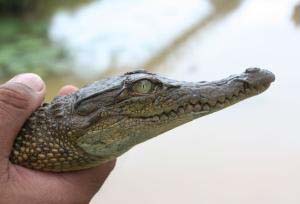Endangered crocodiles get a lake to call their own
Local residents had to be persuaded not to hunt and kill the reintroduced reptiles By Lewis Smith Members of the world's most threatened crocodile species have been re-introduced into the wild in a scheme that many supporters had feared "could never be done". Fewer than 100 fully grown Philippine crocodiles survive in the wild and the species, Crocodylus mindorensis, is on the brink of extinction. But now conservationists have released 50 juvenile Philippine crocodiles which were raised in captivity into a lake on Luzon, the largest island in the Philippines.
Crocodiles have been bred in captivity by the Philippines government since 1987 but no one had dared release any of the creatures until now. Many conservationists said the project would not work because so many of the locals feared and hated the animals that any released crocodiles would be hunted down and slaughtered. It finally went ahead after researchers spent a decade working with local people to convince them to allow the crocodiles to live in peace.
The larger and more deadly saltwater crocodile is also found in the Philippines and its presence has contributed to many people's hatred of the reptiles and their eagerness to kill them. Calling someone a crocodile in the local language is regarded as a gross insult.
Jan van der Ploeg, of Leiden University in the Netherlands, who helped lead the programme, said: "We had to make sure the threats to the species were addressed and that local people were supportive. People still killed them out of fear, for food or for fun. They would kill them to make sure they wouldn't eat livestock or children.
"That we were able to bring these animals out of the farm into the wild for the first time is a great step. For a long time it was thought you couldn't reintroduce them because of the rural population of people. Now we have done it."
Merlijn van Weerd of the Mabuwaya Foundation, who led the project, said: "Many conservationists had already given it up. So apart from establishing a viable wild population of Philippine crocodiles the reintroduction also shows there is hope for Philippine biodiversity at large."
The crocodile, which is only found in the Philippines, is much rarer than the giant panda, the orang-utan or the black rhino, he said. The species used to be common throughout the archipelago but is now restricted to a handful of small islands.
Demand for crocodile-skin handbags and shoes during the 1960s and 1970s was a prime factor in the species being driven almost to extinction. Other threats include the use of dynamite by fishermen to kill or stun fish, which often simultaneously kills or maims the crocodiles. But loss of habitat is the single biggest threat, driven by destruction of the rainforests to make way for rice paddies.
The young crocodiles that were released into the wild at Lake Dicatian were about 4ft (1.2m) long and when fully grown should reach 10ft. Despite their fearsome armoury of flesh-tearing teeth, the animals only attack people when provoked. Fish, shrimps, snails, rats, and snakes are their main prey but adults will take chickens and dogs if given the opportunity.
Lake Dicatian is part of the Northern Sierra Madre National Park which is the crocodile's most important sanctuary. It was chosen for the release in part because no humans live immediately beside it. However, a campsite and observation tower have been built close to the lake in the hope of attracting eco-tourists to the area.
Ten of the released crocodiles were fitted with radio transmitters which allow scientists to follow the animals' movements and see how well they adapt to their new home. Little is known about the behaviour and needs of the species and the data is expected to provide important information that can be used to improve the success rates of future reintroductions.
The reintroduction programme is supported by several UK conservation organisations, including the Rufford Maurice Laing Foundation, which provided funding, and Flora and Fauna International.
The project is part of the Conservation Leadership Programme, a coalition of conservation organisations and BP, which is involved in schemes to help wildlife around the world.
Kiragu Mwangi of Birdlife International, one of the partner groups, said: "This is a great achievement for the project and provides hope for the future of the Philippine crocodile."
The crocodiles released into the wild on 31 July were raised at the Palawan Wildlife Rescue and Conservation Centre and the reintroduction programme was managed by the Mabuwaya Foundation, both in the Philippines.
Reprogramming Predators
